
Tudor Place is a Federal-style mansion in Washington, D.C. that was originally the home of Thomas Peter and his wife, Martha Parke Custis Peter, a granddaughter of Martha Washington. Step-grandfather George Washington left her the $8,000 in his will that was used to purchase the property in 1805. The property, comprising one city block on the crest of Georgetown Heights, had an excellent view of the Potomac River.
Roscoe Harold Zook was an American architect best known for his work in suburban Chicago, Illinois. He received a degree in architecture from the Armour Institute of Technology in 1914. In 1916 Zook married his first wife, Mildred Barnard. They divorced in the late 1930s. They had one son, Harold Barnard Zook, who followed in his father's footsteps to become an architect in Corona del Mar, California. In the early 1940s, Zook married his second wife, Florence (Barkey) Nissen, whom he met through mutual friends. Zook died in April 1949, just short of his 60th birthday.

The Ernest M. Wood Office and Studio is a building located in the Adams County, Illinois city of Quincy. The building was designed by Quincy architect Ernest M. Wood and reflects the designs of Frank Lloyd Wright; as such it is an example of Prairie style architecture. The building, stucco and wood, was completed in 1912 and listed on the National Register of Historic Places on August 12, 1982. The Office and Studio incorporates typical elements of Prairie style such as geometric shapes and horizontals. A restoration during the 1980s helped to repair such features as skylights, stained glass windows and built-in bookcases.

The Ulysses G. Orendorff House is a historic house located at 345 West Elm Street in Canton, Illinois. The house was built in 1902 for Ulysses G. Orendorff, the son of Parlin & Orendorff co-founder W. J. Orendorff; the company, the most successful in Canton, manufactured farming equipment and was later sold to International Harvester. Architect Robert C. Spencer of Chicago designed the house; Spencer was a friend of Frank Lloyd Wright and an early figure in the Prairie School, and the house represents Spencer's shift toward the Prairie School aesthetic from his earlier Tudor style works. Two large gables on the front of the house are decorated with a wooden grid with rows of windows and geometric patterns; while the design resembles half-timbering on its face, it embodies the horizontal emphasis that became a key feature of the Prairie School. The interior of the house is characteristic of the Prairie School, with natural materials and modern decorative elements.

The University of Illinois Experimental Dairy Farm Historic District, also known as South Farm, is a designated historic district in the U.S. state of Illinois. It is located on the campus of the University of Illinois in Urbana, Illinois. The district consists of eight contributing structures and several non-contributing structures. The district was designated in 1994 when it was added to the National Register of Historic Places as part of the Multiple Property Submission concerning Round Barns in Illinois. Three of the district's buildings are early 20th century round barns constructed between 1908 and 1912. The district covers a total area of 6 acres (2 ha).

Christ Church is a historic church in Quincy, Massachusetts. It is a parish of the Episcopal Diocese of Massachusetts. The parish first congregated for lay-led services in 1689, and officially formed in 1704. It is believed to be the oldest continuously active Episcopal parish in Massachusetts. The building is a Tudor Revival structure constructed in 1874; it was listed on the National Register of Historic Places in 1989. The Rev. Clifford Brown is the current rector.
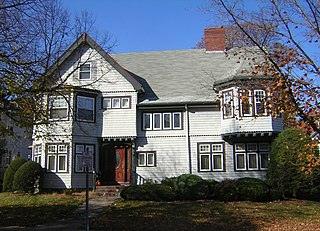
The Arthur Alden House is a historic house at 24 Whitney Road in Quincy, Massachusetts. Built in 1909, it is a good example of a Queen Anne architecture with Shingle style details. It was listed on the National Register of Historic Places in 1989.

Quincy Point Fire Station is a historic fire station at 615 Washington Street in Quincy, Massachusetts. Built in 1941, it is the third firehouse to occupy the location, and is one of the city's finest examples of Colonial Revival architecture. It was listed on the National Register of Historic Places in 1994.

The DuPage County Historical Museum, formerly the Adams Memorial Library, is a building designed by Charles Sumner Frost in Wheaton, Illinois, United States.

The U.S. Post Office and Courthouse is a post office and federal courthouse located at 200 North 8th Street in Quincy, Illinois. The building was designed in 1885 and completed in 1887. Architect Mifflin E. Bell, Supervising Architect at the time, designed the French Renaissance Revival style building. Bell's design was inspired by Richard Morris Hunt's design for the William K. Vanderbilt House in New York City; at the time, the French Renaissance Revival style had not spread to Illinois, which made Bell's work distinctive in the region. The building's design features a limestone exterior, arched entrances and first-floor windows, and an ornate roof with pointed gables and dormers.

The Andridge Apartments is a historic apartment building located at the intersection of Ridge Avenue and Church Street in Evanston, Illinois. The building was built in 1923 and designed by Robert C. Ostergren. The "S"-shaped building has two courtyards, a front courtyard facing Ridge Avenue and a rear courtyard for units on Church Street. The building was designed in the Tudor Revival style and features regularly spaced bays with gables, limestone trim, and Tudor arches around its entrances. On March 15, 1984, the building was added to the National Register of Historic Places.
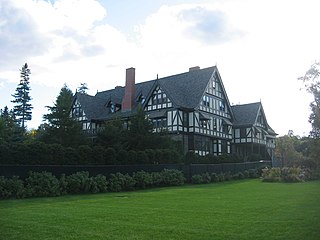
The John Innes Kane Cottage, also known as Breakwater and Atlantique, is a historic summer estate house at 45 Hancock Street in Bar Harbor, Maine. Built in 1903-04 for John Innes Kane, a wealthy grandson of John Jacob Astor and designed by local architect Fred L. Savage, it is one of a small number of estate houses to escape Bar Harbor's devastating 1947 fire. An imposing example of Tudor Revival architecture, it was listed on the National Register of Historic Places in 1992.

The Edward Kirk Warren House and Garage is a historic house located at 2829-2831 Sheridan Place in Evanston, Illinois. The house was built in 1910-12 for Edward Kirk Warren, an industrialist who developed the featherbone corset. Warren also served as president of the International Sunday School Association and provided financial support to evangelist Dwight L. Moody. Architect William Carbys Zimmerman, the Illinois State Architect at the time, designed the Tudor Revival house. The house was built from dressed ashlar, an uncommon building material for Tudor Revival houses; it is one of only two ashlar Tudor Revival houses in Evanston. The house's roof has a steep main gable with a parapet along with several smaller gables and dormers with a similar design. The entrance porch is supported by columns and covered by an overhang with bracketed eaves. An octagonal tower with ornamental griffins and a crenellated battlement rises to the left of the entrance. Other decorative features used in the exterior include stained glass, arched windows, and various patterns inlaid in the stone.

The Alpha Delta Phi Fraternity House was a historic fraternity house located at the University of Illinois at Urbana–Champaign in Champaign, Illinois. The house was built in 1924-25 for the university's chapter of the Alpha Delta Phi fraternity, which formed in 1903. During its early years, the fraternity's members included several prominent university athletes. Architect Ralph W. Varney designed the building in the Tudor Revival style. The house's design reflected the formal Jacobethan subtype of Tudor Revival architecture, which could be seen in its extensive stone decorations on its brick exterior, such as quoins and oriels, and its steep gable roof with gabled dormers. Half-timbering, a common feature of informal Tudor Revival designs, was notably absent.
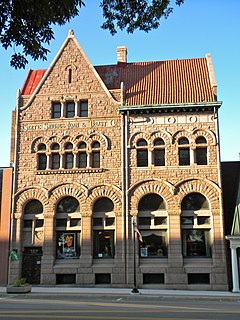
State Savings Loan and Trust is a historic bank building located at 428 Maine Street in Quincy, Illinois. The bank was built in 1892 for brothers Lorenzo and Charles H. Bull, who were prominent Quincy businessmen and community leaders. Chicago architectural firm Patton & Fisher designed the bank in the Richardsonian Romanesque style; local architect Ernest M. Wood designed an addition for the building in 1906. The building has a five-bay facade, with three bays on the original portion and two on the addition; the bays are each marked by a window with a thick stone arch. The original section is topped by a large front-facing gable, providing for attic space above the second story.

Ernest Michael Wood was an architect based in Quincy, Illinois. A Quincy native, Wood entered into architecture in 1886 as a draftsman of Quincy architect Harvey Chatten. Wood remained in Chatten's practice until 1891, when he opened his own practice; collaborative works by the two include the Richard F. Newcomb House, a Richardsonian Romanesque home completed in 1891. During the early part of his career, Wood mainly designed buildings in popular period styles; examples of this period of his work include the 1900 Tudor Revival One Thirty North Eighth Building and his 1906 addition to the Romanesque State Savings Loan and Trust Company building. In the 1900s, though, Wood began to study the work of Frank Lloyd Wright and the Prairie School. Wood corresponded with Wright, and his work is largely responsible for introducing the Prairie School to the Quincy region. Wood's office and studio, which he completed in 1911, was his first major Prairie School work and his introduction of the design to Quincy. In addition to his work in Quincy proper, Wood also designed Prairie School homes in Camp Point and Warsaw in Illinois and Hannibal and Palmyra in Missouri.
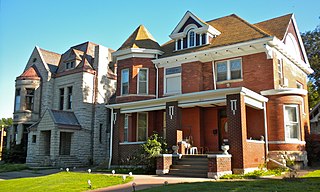
The Quincy Northwest Historic District is a primarily residential historic district in Quincy, Illinois, USA. Located north and west of the city's downtown, the district encompasses over 1,600 contributing buildings; these buildings represent almost every prominent architectural style used between 1840 and 1950. The district developed somewhat irregularly, with no consistent plan or progression; however, development roughly spreads away from downtown and the Mississippi River. While most buildings in the districts are homes, businesses and industrial buildings are interspersed in residential areas without forming clear areas of non-residential use. The Italianate and Queen Anne styles are the two most prevalent of the many formal architectural styles which can be seen in the district; common vernacular styles include the gable front house, the shotgun house, the I-house and the bungalow.
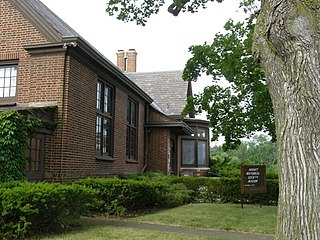
Hobart Carnegie Library, also known as the Hobart Historical Society Museum, is a historic Carnegie library located at Hobart, Lake County, Indiana. It was built in 1914-1915, and is a one-story, Tudor Revival style brick building. The building has a high-pitched slate gable roof and a polygonal bay with leaded glass windows and entry porch. The building was constructed with a $16,000 grant from the Carnegie Foundation.
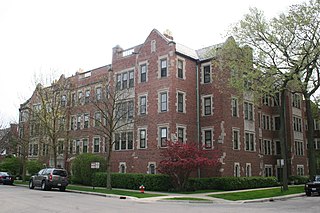
The Building at 999 Michigan, 200 Lee is a historic apartment building at the southeast corner of Michigan Avenue and Lee Street in Evanston, Illinois. The three-story brick building was built in 1927. Architects McNally and Quinn designed the Tudor Revival building. The building's design features arched entrances, projecting bays, limestone window moldings, decorative gargoyles, and a parapet with several gables. The Tudor design continues in the building's interior, which includes wood panels in its lobby, wrought iron balustrades on its staircases, and marble fireplaces in the apartments themselves.
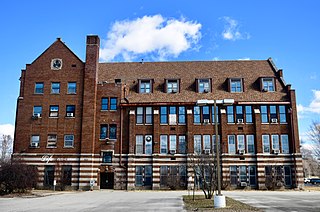
St. Thomas Catholic High School for Boys is a former Catholic high school building at 921 W. State Street in Rockford, Illinois. The Diocese of Rockford opened the school along with a corresponding girls' school in 1929 to address rising enrollment. Rockford architect Wybe Jelles Van der Meer designed the school in the Gothic Revival style, which was commonly used for Catholic churches and schools. The school's design borrows elements from several subtypes of Gothic Revival, including Tudor Gothic and Collegiate Gothic. It includes a gable roof with a side gable at its eastern end, multicolored brick striping on the first floor, dormers on the north and south sides of the roof, a stone entrance bay with a turret, and trefoil arches and windows. The school closed in 1963 and has since been used as an office building by several Catholic organizations.




















